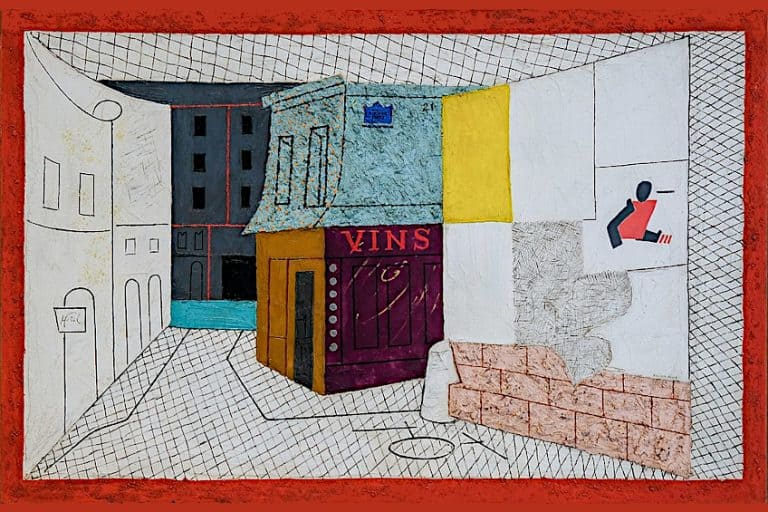What Is 3D Art? – The Cultural Boom of Art in the Third Dimension
This post may contain affiliate links. We may earn a small commission from purchases made through them, at no additional cost to you.
What Is 3D art? That is the question. We tend to think of a concept like three-dimensional artwork as recent, but that is not actually the case. In this article, we will provide a three-dimensional art definition, the different types of three-dimensional art, the differences between 3D and 2D art, the ways in which 3D art has been used in traditionally 2D spaces, and a few three-dimensional art examples. If this sounds interesting, keep reading!
Table of Contents
What Is 3D Art?
The term “3D art” sounds so digital. It would be understandable for someone to assume, based on the present uses of a term like this, that “3D” refers to video games or 3D printing, but that is not the case. These forms of art that were just mentioned are indeed 3D artforms, but they are digital forms. There are more analog forms of 3D art too. That is what much of this article will be about.

Okay, so if digital 3D art is not the same as 3D art, then what is 3D art? Well, three-dimensional art is any kind of art that makes use of all three dimensions available to human experience. The three dimensions are, quite simply, height, width, and breadth. This is rather simple when one thinks about it, but it can be easy to become confused because of the common usage of certain terms. However, it would be best to have a look at a few different three-dimensional art examples to truly understand this form.
The Types of Three-Dimensional Art
There are many different varieties of 3D art. Some of the most obvious of these are more analog forms such as sculptures. Sculptures are quite literally rendered in three-dimensional space, and they can be rotated 360 degrees to see the full height, width, and breadth. However, there are also other forms of analog 3D art.
Some of the others are forms of three-dimensional paintings, like those that make use of trompe l’oeil. This is a technique that was quite common during the Baroque era. It is a blending of both painting and sculpture to produce an effect that deceives the eye. This gives what would otherwise simply be a painted surface a degree of texture otherwise not ordinarily seen. There are many other forms too, such as carvings, which are quite closely related to sculptures in a more general sense, or pottery, which is the use of ceramic to construct items that often serve specific functions.
These 3D artworks are then often supplemented with additional elements, such as paint. This allows for further effects to be produced.
However, the digital age has given rise to a far more comprehensive array of three-dimensional art possibilities. Some examples of these elaborated forms include the use of 3D computer-generated artworks that can be used in virtual interactive spaces, such as video games and virtual reality applications, but they can also be used to supplement architecture to create new forms. Then there is, of course, the more contemporary rise of the 3D printer. These devices allow for full three-dimensional objects to be created beforehand in a computer program and then those schematics are fed into a 3D printer. These 3D printers can then construct perfect recreations of what was in the simulated version.
The term “3D art” still tends to confuse though as these latter forms are generally seen as 3D while older, more analog forms are not. The terms 2D and 3D, especially when using those shortened forms rather than two-dimensional and three-dimensional, calls to mind technology. Everything recorded in a live-action film was, after all, three-dimensional, but a 3D movie is something completely different.

Our vocabulary can easily become confused because of changes in common usage. This is also why, for example, we perceive something as three-dimensional when it is actually being projected onto a two-dimensional screen. For instance, all movies are actually projected on a 2D plane, but we think of them as 3D (especially when the movie we’re watching is from Pixar rather than a traditional Disney cartoon).
However, we actually perceive all screen-based artforms in a 2D sense. For instance, strapping on a VR headset may lead one to think of it as a 3D world that one is now entering, but you’re technically entering that world through a pair of two-dimensional screens. This is a semantic argument though, but a fun one! Without all the semantic argumentation though, a piece of 3D art is, quite simply, one that is not 2D. It has all three of the dimensions that are accessible to us.
But let’s make sure anyway, what are the differences between 3D and 2D art?
The Differences Between 3D and 2D Art
In terms of the differences between these two, they are rather simple. 2D art makes use of two dimensions, and 3D art makes use of three dimensions. Any piece of art that makes use of height, width, and breadth is an example of three-dimensional art. As has already been stated, this means that sculptures, video games, and carvings all form part of the far broader label of three-dimensional art.

2D, on the other hand, does not make use of all three and is instead projected on a flat surface. This means that it only makes use of length and width. However, 2D art has long made use of certain 3D techniques. For instance, the use of perspective and depth is an attempt to create a certain illusion that makes a 2D image appear more three-dimensional. It should be remembered that this is an illusion though. A 2D painting that makes use of perspective techniques is still on a flat surface.
In terms of 3D art, there is no need for an illusion of depth because it is, by its very nature, already three-dimensional. This is also why there have been more contemporary uses of three-dimensional art technology to somewhat speed up the process of having to create perspective and carefully place everything within a 2D plane.
So, let’s have a look at how that is sometimes done.
The Use of 3D Technology in Traditionally 2D Art Spaces
In the most basic sense, 2D artists have been making use of 3D technology for quite some time in the form of simply using computers. Computers allow for a variety of functions that can aid 2D artists and allow them to better produce the kind of art that they want to produce. This can come in the form of making use of 3D renders to determine the best way to position figures within a 2D painting.

One could also remove the middleman and create 2D artwork through 3D technology. For instance, animation technology can be used to create realistic or stylized 3D models. Those models can then be posed, and the position of the camera can be tweaked to determine the best position. From there, a still image can be captured and used as a 2D artwork. This can help with positioning because 3D rigging of characters entails building a skeletal frame that can be moved and positioned realistically without accidentally making biological mistakes like positioning an arm where it would not actually be able to be.
In addition to simply making use of tools such as this, 3D virtual spaces can be used to exhibit 2D artworks or allow for them to be interacted with in ways that would otherwise be difficult without being in person. There are many ways that 3D technology can be used to aid and supplement 2D artforms, but it is worth remembering that 2D art forms can also aid in 3D artforms.
This is especially the case in the planning phases because 2D artworks are still often used to plan out more intricate 3D art forms, like animated movies.
Some Three-Dimensional Art Examples
There are many fantastic examples of three-dimensional art pieces out in the wide world, but some of the most significant of them may be older forms of 3D art like Michelangelo’s David statue. This famous Renaissance statue has become one of the most famous sculptures to have ever been designed. It is also considered to be one of the most influential sculptures that has ever been created. In terms of more modern 3D forms, something like post-2009 Disney films have exclusively focused on 3D animated techniques rather than the more traditional 2D forms for which they had become so immensely famous. Movies like Wreck-It Ralph, Zootopia, and Encanto make use of 3D animation technology that has become the most common method used to produce animated films in the present day.

In terms of more contemporary sculpted artworks, something like the work of Monika Horčicová is a good example of what can be done with 3D printing. Her work, such as the Wheel of Life, typically makes use of human bone designs that are rendered and then printed. These are made of either resin or plaster and are used as symbolic representations of the circle of life and death. Her three-dimensional artworks are purely within the more contemporary tradition. There are many other three-dimensional art examples out in the world, but this is a short list of some of the more notable instances. 3D art comes in many shapes and sizes. Some of these artforms are incredibly old and others are being made at this very moment somewhere in the world. What we do know for certain is that more and more of it will be made the longer we stick around and wait to see what comes.
3D art has always been all around us. It can be easy to get swept up in contemporary usage of terms like this, but it is worth remembering that both 2D and 3D artforms have been around for as long as humans have been making art. In this article, we examined 3D art to some degree, such as by looking at some of the different types of 3D art, the differences between 3D and 2D, and some of the uses of 3D technology going forward.
Frequently Asked Questions
What Is 3D Art?
3D art is a form of art that, as the name may suggest, makes use of all three dimensions that are available to human perception. This means that these forms of art make use of height, width, and breadth. Some common three-dimensional art examples include sculptures and carvings.
What Are Some of the Most Common Types of 3D Art?
There are many different forms of art that can be considered 3D artworks. The most common three-dimensional art examples in an analog sense would be items such as sculptures, pottery, and carvings. However, digital examples of 3D art might include three-dimensional renders in interactive environments like video games, three-dimensional paintings, or items made using a 3D printer.
What Are the Differences Between 3D and 2D Art?
The primary difference between these two forms of art is that one includes all three dimensions available to us, and the other only uses two. 2D art excludes breadth. While 2D art includes paintings, 3D art includes sculptures. There are digital forms of both of these general varieties.
How Is 3D Art Technology Now Used in 2D Art Spaces?
In the age of technology that we now live in, computer programs can be used to create 2D artworks. Many of these forms of technology are actually meant to be implemented for 3D purposes. For instance, software such as animation tools can be used to create characters that are posed, and those poses form the bases of photographs that are presented in a 2D sense.
What Are Some of the Most Famous Examples of 3D Art?
Some of the most famous three-dimensional art examples include sculptures such as Michelangelo’s David, every modern Disney film that makes use of 3D animation technology, and 3D printed artworks such as Monika Horčicová’s Wheel of Life design. There are many instances of 3D art throughout the world, but these are some of the most famous from both the analog and digital traditions.
In 2005, Charlene completed her wellness degrees in therapeutic aromatherapy and reflexology at the International School of Reflexology and Meridian Therapy. She worked for a company offering corporate wellness programs for several years before opening her own therapy practice. In 2015, she was asked by a digital marketer friend to join her company as a content creator, and it was here that she discovered her enthusiasm for writing. Since entering the world of content creation, she has gained a lot of experience over the years writing about various topics such as beauty, health, wellness, travel, crafting, and much more. Due to various circumstances, she had to give up her therapy practice and now works as a freelance writer. Since she is a very creative person and as a balance to writing likes to be active in various areas of art and crafts, the activity at acrylgiessen.com is perfect for her to contribute their knowledge and experience in various creative topics.
Learn more about Charlene Lewis and about us.







